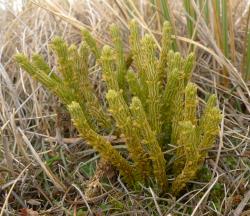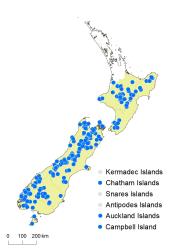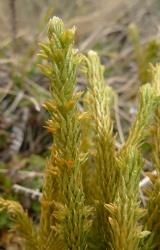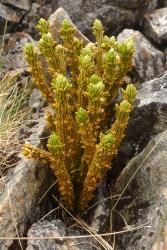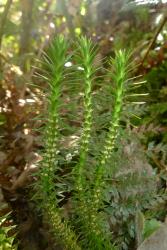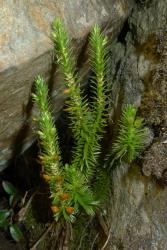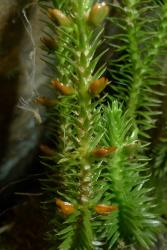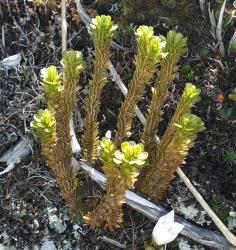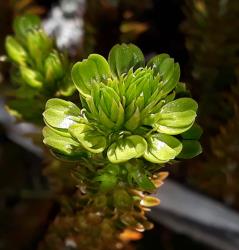- Taxon
- Gallery
- ≡ Lycopodium australianum Herter, Bot. Jahrb. Syst. 43: Beiblatt 98: 42 (1909)
- ≡ Urostachys australianus (Herter) Herter ex Nessel, Bärlappgewächse 49 (1939)
- = Urostachys cockaynei Herter ex Nessel in Nessel, Revista Sudamer. Bot. 6: 158, t. 7, f. 12 (1940)
Horizontal stems absent. Aerial stems erect or decumbent, unbranched or branching dichotomously 1–4 times, 35–480 mm long, 4–18 mm wide (including leaves). Sterile leaves monomorphic, spirally arranged, decreasing in size slightly towards the apex, appressed or spreading, narrowly ovate, apices acute or acuminate, margins entire or minutely toothed at apex, bases adnate, 3–10 mm long, 0.8–1.4 mm wide, dull green or tinged orange. Bulbils present on the stems. Sporophylls similar to sterile leaves, confined to upper half of stem, not aggregated into strobili.
Huperzia australiana is easily recognised by the presence of bulbils in the axils of the leaves, and is the only species of Lycopodiaceae in New Zealand that is bulbiferous. It is also distinguished by its upright, terrestrial habit, and by the absence of distinct strobili.
North Island: Volcanic Plateau, Gisborne, Taranaki, Southern North Island.
South Island: Western Nelson, Sounds-Nelson, Marlborough, Westland, Canterbury, Otago, Southland, Fiordland.
Chatham Islands, Stewart Island, Auckland Islands, Campbell Island.
Altitudinal range: 100–1900 m.
Huperzia australiana occurs in montane and subalpine regions of the North Island from the Raukūmara Range and Rotorua south to the Tararua Range. It is mostly found from 500 m to 1750 m, but has been recorded down to 250 m in the western Waikato. There is a record from Waipoua Forest (AK 99780), but the locality is considered doubtful and has not been mapped. In the South Island the species occurs throughout in montane to alpine areas, usually between 450 m and 1900 m, but occasionally down to 100 m in Westland. It also extends to the Chatham Islands, Stewart Island, the Auckland Islands and Campbell Island.
Also Borneo, Sumatra, Java, Celebes, Papua New Guinea, Australia (New South Wales, Victoria, Tasmania) and Macquarie Island.
Huperzia australiana grows terrestrially, often on stream banks, in podocarp and beech forest, under mānuka, Olearia and Dracophyllum scrub, in subalpine shrub and herbfield, in tussock grassland, on boulders, on rock outcrops and in crevices, on scree and cliffs, and in boggy ground. It occurs on greywacke, limestone, marble, ultramafic rock, and on a range of volcanic rock types.
The name Lycopodium selago L. used in many earlier New Zealand Flora treatments is a misidentification of Huperzia australiana.
Allan (1961) made the superfluous new combination Lycopodium australianum (Herter) Allan, believing incorrectly that Herter’s original basionym was Urostachys australianus, rather than Lycopodium australianum.



